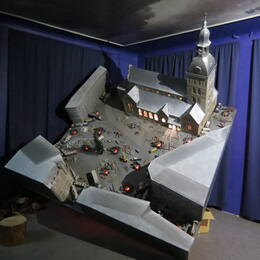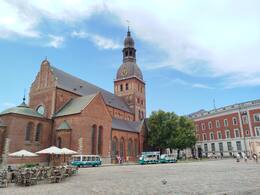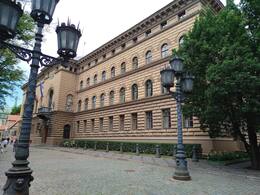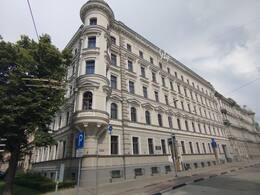Nuo Rėzeknės iki 1991 m. barikadų
Pasakotojai aprašo barikadų laikotarpio nuotaikas ir asmeninius išgyvenimus. Prisiminimai gerai iliustruoja, kaip informacija pasiekė Latvijos gyventojus visoje jos teritorijoje.
Juris Kudurs: „1991 m. dirbau mokytoju Feimanių pradinėje mokykloje ir buvau aktyvus Latvijos liaudies fronto narys. Reguliariai sekiau politinius įvykius Latvijoje ir pasaulyje. Išgirdęs apie įvykius Vilnyje ir Dainio Īvāno raginimą rinktis į Latvijos liaudies fronto organizuojamą „Visos Latvijos protesto manifestaciją“, kuri turėjo vykti Daugmaloje, nė kiek neabejojau – privalau vykti! Anksti ryte su Pēteriu Vilumu autobusu išvykome į Rėzeknę, kur rajono komitetas jau buvo suorganizavęs autobusus demonstracijai, kurioje dalyvavo apie 500 000 žmonių, kad išreikštų paramą lietuviams ir Latvijos vyriausybei. Po demonstracijos Dainis Īvānas ir Romualdas Ražukas paragino žmones likti Rygoje, kad apsaugotų svarbiausius strateginius objektus. Mano pareiga buvo likti Rygoje, kad galėčiau dalyvauti šiuose renginiuose. Priimti tokį sprendimą nebuvo lengva, nes gimė nauja moteris ir maža mergaitė. Vakare Rygos gyventojai pradėjo...“ statyti barikadas iš betoninių blokų, taip pat važiavau sunkiąja technika, kad apsaugočiau Aukščiausiąją Tarybą, Ministrų Tarybą, radiją Domo aikštėje, televizijos centrą Zaķusaloje ir Telefono bei telegrafo stotį. Staiga išgirdau didžiulį triukšmą nuo Dauguvos pusės Domo aikštėje, atrodė, lyg važiuotų tankai, jie buvo pirmieji sunkiosios transporto priemonės, pradėjusios statyti barikadas. Taip pat uždegė pirmieji laužai, prie kurių šildėmės šaltomis žiemos naktimis. Šiomis neramiais dienomis ir naktimis aplankiau kelis objektus. Ryškiausios akimirkos išliko mano atmintyje, kai milicijos pulkininkas Domo aikštėje savo vyrams aiškino, kaip sustabdyti tankus laužtuvais. Mačiau, kad viršutiniuose pastatų aukštuose buvo paruošti padegamojo mišinio buteliai. Visi ruošėsi blogiausiam. Vakarais jautėme bendruomeniškumo jausmą – grojo muzika, gėrėme arbatą, šildėmės prie laužų, bet „Nerimas dėl to, kas bus rytoj ar poryt, niekada manęs neapleido. Niekas neturėjo tikro aiškumo, todėl visi laukė, kas bus toliau.“ Šie 1991-ųjų sausio įvykiai visada išliks ryškūs mano atmintyje ir aš galėsiu juos papasakoti savo anūkams kaip liudininkas.“
Antonas Reiniksas prisimena: „Kadangi buvau Liaudies fronto narys, man buvo akivaizdu, kad turiu vykti į Rygą. Parapijos tarybos pirmininkė Elvyra Pizāne paskelbė, kad sausio 14-osios vakare iš Rėzeknės rajono tarybos išvyks autobusas į Rygą. Buvo pakviesti ir kiti, bet jie atsiprašė, kad namuose turi mažų vaikų ir turi rūpintis namų ūkiu. Elvyra mane nuvežė parapijos „Moskviča“ į Rėzeknės rajono tarybą, kur jau buvo susirinkę vyrai iš kitų parapijų. Autobuse visiems buvo patarta ant popieriaus lapo užrašyti savo vardą, pavardę ir kraujo grupę ir įsidėti jį į kišenę. Žinojome apie kruvinus įvykius Vilnijoje, buvo nežinia, kas bus, bet turėjome vykti. Pamenu, kaip Dekšārese į autobusą įlipo drąsūs, patriotiškai nusiteikę vyrai, ir dvasia atgijo.
Į Rygą įvažiavome apie vidurnaktį. Mus nuvežė į Zaķusalą prie televizijos bokšto. Ant Salos tilto stovėjo sunkiosios technikos ir malkvežių kolonos. Prie televizijos bokšto jau buvo tūkstančiai žmonių, degė laužai, grojo muzika. Malkos jau buvo atvežtos ir mes kūrenome savo laužą, kad naktį sušiltume ir susivienytume su likusia tauta. Dieną žmonių buvo mažiau, bet vakarais ir naktimis aikštės buvo pilnos. Tokia stipri tautinė vienybė gali egzistuoti tik ant barikadų. Turime dėkoti Dievui, likimui ir žmonių dvasios stiprybei, kad šiandien turime savo šalį ir laisvę. Išmokime tai vertinti.“
https://rezeknesnovads.lv/tavs-stasts-barikazu-dalibnieku-atminu-stasts/ (žiūrėta 2021-07-20)
Susijusi laiko juosta
Susijusios temos
Susijusios vietos
Atminimo akmuo 1991 m. barikadoms atminti
Pirmąjį memorialą Latvijoje, skirtą 1991 m. barikadų laikotarpiui atminti, savo granito gaminių individualioje įmonėje pagamino Valmieros gyventojas Jānis Sprudzāns, o pamatus sukūrė SIA „Grods“. Memorialo idėjos autorius buvo Valmieros policijos majoras Aleksandras Melngāršas (1954–2014), kuris vadovavo Valmieros policijos pareigūnų grupei 1991 m. sausio įvykių Rygoje metu. Memorialinio ženklo eskizus ir dizainą sukūrė Dainis Saulītis. Jis buvo atidengtas 2002 m. sausio 24 d. Iš pradžių memorialinis ženklas buvo pastatytas Rygos ir Granto gatvių kampe privačioje žemėje, o vėliau, 2010 m., perkeltas į priešais esantį Valstybinės policijos Vidžemės regiono administracijos pastatą.
1991 m. barikadų muziejus
Muziejus yra Senojoje Rygoje, netoli Rygos katedros. Jis buvo įkurtas 2001 m., siekiant išsaugoti istorinius 1991 m. įvykių Latvijoje įrodymus. Taip pat galima virtualiai aplankyti muziejų. 1991 m. sausį Lietuvoje Sovietų armija apšaudė prie Vilnios televizijos bokšto susirinkusius žmones ir tankais įvažiavo į minią. Reaguodama į šiuos įvykius, Rygoje buvo surengta apie 500 000 žmonių demonstracija, kuria siekta parodyti paramą lietuviams ir Latvijos žmonių pasirengimą tęsti kovą už Latvijos nepriklausomybę. Siekdami užkirsti kelią panašiems įvykiams Latvijoje, gyventojai pradėjo statyti barikadas siaurose Senosios Rygos gatvėse, kad užkirstų kelią galimiems Sovietų armijos išpuoliams prieš barikadų gynėjus. Šios barikados taip pat buvo kuriamos įvairiuose strateginiuose objektuose ne tik Rygoje, bet ir visoje Latvijoje. Ginant barikadas dalyvavo apie 50 000 žmonių iš visos Latvijos. Barikados buvo populiarus judėjimas, padėjęs atgauti Latvijos nepriklausomybę. Tai puikus nesmurtinio pasipriešinimo pavyzdys viso pasaulio istorijoje.
Domo aikštėje Senojoje Rygoje
Domo aikštės svarbą Atbudimo laikotarpiu daugiausia lėmė dvi aplinkybės – ji buvo įsikūrusi visai šalia Latvijos SSR Aukščiausiosios Tarybos pastato, taip pat tai, kad aikštėje yra Latvijos radijo pastatas. Domo aikštėje buvo rengiami įvairūs veiksmai, kurių metu Aukščiausiajai Tarybai buvo keliami reikalavimai, pavyzdžiui, 1989 m. liepos 26 d. Latvijos darbo federacija surengė mitingą, kuriame dalyvavo 60 000 žmonių, reikalaudama, kad Aukščiausioji Taryba priimtų Suvereniteto deklaraciją. Būtent šiame mitinge buvo iškeltas tuo metu populiarus šūkis „Kažkas praeityje, bet laisvoje Latvijoje“.
Kupolo aikštė buvo pagrindinė barikadų gynėjų susibūrimo vieta 1991 m. sausį, saugojusi Aukščiausiąją Tarybą ir Radijo rūmus. Barikadų gynėjai šildėsi prie laužų. Jie taip pat apsistojo Radijo rūmuose ir Kupolo bažnyčioje. Bažnyčioje buvo įrengta pirmosios pagalbos stotis, vyko pamaldos. Vakarais aikštėje improvizuotoje scenoje koncertavo populiarios roko grupės. Kiekvienais metais Kupolo aikštėje rengiami barikadų minėjimo renginiai.
Netoli Domo aikštės, Krāmu gatvėje 3, yra 1991 m. barikadų muziejus. 2018 m. sausio 13 d. Domo bažnyčioje buvo atidengtas menininkų Krišo ir Dzintaro Zilgalvjų vitražas „Su aistra už laisvą Latviją“ – dedikacija 1991 m. barikadoms ir Latvijos nepriklausomybei.
Parlamento rūmai (Saeima)
Buvusiuose Vidžemės riterių namuose nuo 1922 m. įsikūręs Latvijos parlamentas. Sovietų okupacijos metu čia buvo įsikūręs pseudoparlamentas – Latvijos SSR Aukščiausioji Taryba. 1990 m. kovo mėn. vykusiuose Aukščiausiosios Tarybos rinkimuose pagrindinis klausimas buvo Latvijos valstybinės nepriklausomybės atkūrimas. Tai buvo padaryta laikantis Latvijos liaudies fronto pozicijos, kuri teigė, kad realiau tai padaryti pasinaudojant esamomis SSRS valdžios struktūromis. Norint laimėti kvalifikuotą balsavimą Aukščiausiojoje Taryboje, reikėjo 134 balsų.
1990 m. gegužės 4 d. Latvijos TSR Aukščiausioji Taryba priėmė deklaraciją „Dėl Latvijos Respublikos nepriklausomybės atkūrimo“. Už jos priėmimą balsavo 138 deputatai, 1 susilaikė, tačiau 57 deputatai, pasisakę už Latvijos likti SSRS sudėtyje, balsavime nedalyvavo. Priėmus deklaraciją, Latvijos teritorijoje buvo atkurta 1922 m. Konstitucija, tačiau iki naujos Konstitucijos redakcijos priėmimo jos galiojimas buvo sustabdytas, išskyrus pirmuosius tris Konstitucijos straipsnius. Toks pereinamasis laikotarpis buvo nustatytas iki Latvijos Respublikos Saeimos sušaukimo. Gegužės 4 d. minima Latvijos Respublikos nepriklausomybės atkūrimo diena.
1990 m. gegužės 15 d. nepriklausomybės priešininkai, pasitelkę civiliais drabužiais apsirengusius karo kadetus, bandė užimti Aukščiausiąją Tarybą, tačiau spontaniškai susiorganizavę Politechnikos instituto ir Kūno kultūros instituto studentai atrėmė puolimą. Antrąjį bandymą pulti Aukščiausiąją Tarybą sustabdė milicija (OMON dalinys, kuris 1990 m. birželį atsisakė paklusti Latvijos Respublikos vyriausybei ir tapo pagrindine nepriklausomybės priešininkų smogiamąja jėga).
Aukščiausioji Taryba 1991 m. sausį buvo vienas svarbiausių barikadų apsaugos taškų. Jos prieigos buvo aptvertos gelžbetonio blokais, ir šios apsauginės konstrukcijos ten buvo iki nesėkmingo perversmo Maskvoje 1991 m. rugpjūčio 19–21 d. Sovietų Sąjungos desantininkams ir OMON kovotojams nepavyko užimti Aukščiausiosios Tarybos, o jos deputatai tęsė savo darbą. Rugpjūčio 21 d., 13 val., keturi OMON šarvuočiai įžengė į Domo aikštę ir liko ten iki 14 val. 10 min., bandydami įbauginti deputatus, kurie tuo metu (13 val.) priėmė Konstitucinį įstatymą dėl Latvijos Respublikos valstybinio statuso (už balsavo 111 deputatų, 13 – prieš). Tai panaikino 1990 m. gegužės 4 d. nustatytą pereinamąjį laikotarpį, skirtą de facto atkurti valstybės valdžią Latvijos Respublikoje, ir Latvija atgavo visišką nepriklausomybę. 2007 m. prie Saeimos rūmų Jėkabos gatvėje buvo atidaryta 1991 m. sausio barikadų atminimo vieta, o 2000 m., minint Latvijos Respublikos nepriklausomybės atkūrimo 30-ąsias metines, prie pagrindinio Saeimos įėjimo buvo įrengta atminimo lenta su užrašu: „Šiame pastate 1990 m. gegužės 4 d. Aukščiausiosios Tarybos deputatai priėmė deklaraciją dėl Latvijos Respublikos nepriklausomybės atkūrimo“.
Bastejkalns rajonas Rygoje
Bastėjokalnio apylinkėse yra keletas barikadų laikų memorialinių vietų. Aikštė, esanti Smilšu ir Torņa gatvių sankryžoje, priešais Parako bokštą, 2016 m. buvo pavadinta 1991 m. Barikadų aikšte. Čia dislokuota sunkioji technika saugojo Senąją Rygą nuo įsiveržimo į strategiškai svarbią vietą. Netoliese esančiame Latvijos karo muziejuje buvo įsikūręs pirmasis barikadų stulpas.
1991 m. sausio 20 d. Bastejkalns apylinkėse įvyko OMON išpuolis prieš Vidaus reikalų ministeriją, nusinešęs kelių žmonių gyvybes. Kanalo pakrantės žalumose, priešais Bastejkalnsą, tose vietose, kur aukos buvo mirtinai sužeistos, pastatyti memorialai – akmenys milicijos leitenantui Vladimirui Gamanovičiui, vidaus reikalų departamento inspektoriui Sergejui Kononenko, Rygos kino studijos direktoriui Andriui Slapiniui, moksleiviui Edijui Riekstiniui ir nušauto vaizdo operatoriui Gvido Zvaigznesui, žuvusiems vasario 5 d. Yra versija, kad šauliai buvo ne tik OMON nariai, bet ir kokia nors „trečioji jėga“ – arba iš specialiojo dalinio „Alfa“, arba SSRS valstybės saugumo komiteto darbuotojai iš Maskvos, kurie išprovokavo OMON išpuolį prieš Vidaus reikalų ministeriją.
Kanalo pakrantės soduose taip pat pastatytas atminimo akmuo 1991 m. rugpjūčio 19 d. aukai Raimondui Salminiui, kurį riaušių policija nušovė netoli Rygos miesto policijos nuovados pastato Aspazijas bulvaro ir 13-osios gatvės sankryžoje. 2014 m. prie buvusio Vidaus reikalų ministerijos pastato Rainio bulvaro ir Reimersos gatvės kampe buvo įrengta atminimo lenta, skirta 1991 m. sausio 20 d. išpuolio prieš Vidaus reikalų ministeriją aukoms atminti.




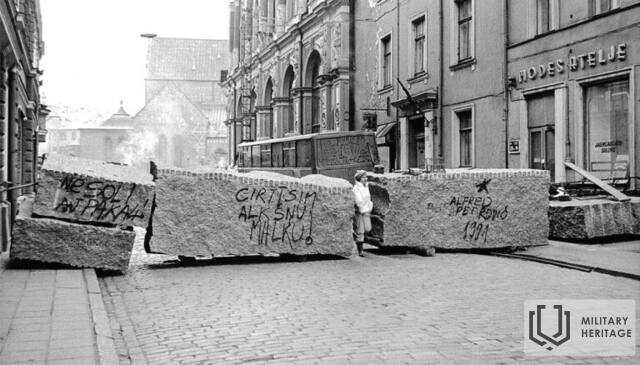


![Atminimo akmuo 1991 m. barikadoms Rygos gatvėje Valmieroje atminti. Šaltinis: „Valmiera“ [iliustruotas leidimas], išleido leidykla „Jumava“, 2008. - p. 87. Autorius: Nils Smelteris.](/g/Poi/00540/Dzelzcela-tilts-Valmiera_1922g2.jpg?size=260)
